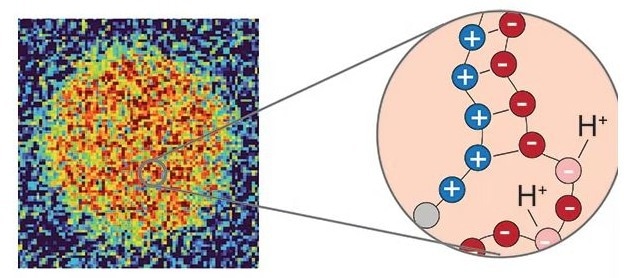Researchers from the lab of Rohit Pappu and associates at the Center for Biomolecular Condensates have figured out how nucleolar sub-structures are assembled, a first for the condensate field.
 The pictured circle is a nucleolus, a type of cellular condensate, and the measured pH gradient. Image Credit: Pappu lab
The pictured circle is a nucleolus, a type of cellular condensate, and the measured pH gradient. Image Credit: Pappu lab
Scientists studying the physical and chemical features that regulate biomolecular condensates now have a critical method for measuring pH and other emergent aspects of these cellular compartments.
Protein and nucleic acid communities make up condensates. They have no membrane, so they can come together or separate as needed. One notable condensate in cells is the nucleolus. It produces ribosomes and plays essential roles in cellular physiology.
The multiprotein and RNA assemblies known as ribosomes are where the genetic code is translated to produce proteins. Defects in ribosome production and other nucleolar dysfunctions primarily cause cancers, neurodegeneration, and developmental disorders.
Researchers from the Center for Biomolecular Condensates at the McKelvey School of Engineering at Washington University in St. Louis, along with colleagues, have figured out how nucleolar sub-structures are assembled, a first for the condensate field. Rohit Pappu is the Gene K. Beare Distinguished Professor of Biomedical Engineering. They investigated and compared the pH of nearby non-nucleolar condensates, such as nuclear speckles and Cajal bodies, with the distinct pH profiles that result from this arrangement within nucleoli.
The authors of the study, which was published online in Cell, state that while nuclear speckles and Cajal bodies have more basic pH values, nucleoli have different protein compositions that give them an acidic character.
Utilizing novel algorithms created by McKelvey staff research scientist Kiersten Ruff and colleagues in the Pappu lab, along with spatial proteomics data from Emma Lundberg’s lab, an associate professor of bioengineering at Stanford University, the team identified distinct “molecular grammars,” one of which being the presence of long acidic tract proteins, a crucial characteristic that distinguishes many nucleolar proteins. The group reasoned that since pH is a measure of the activity of protons, this must aid in the transport of hydrogen protons into nucleoli.
Condensates resemble a crowd on the exhibit floor of a convention. No walls are holding them in place—just a few pivotal figures leading dazzling discussions that serve as their “scaffolds.” Emergent properties in the condensates, such as the internal pH in nucleoli, are made possible by the community of molecules that come together.
The mechanism by which condensates occur is now known as condensation by the team. This combines sticky interactions between molecules that like to bind together with phase separation, like when water and oil separate.
Biomolecules are defined by a combination of specific interactions and distinct solubility profiles. Condensation involves the totality of these interactions, and this gives rise to what are known as emergent properties.”
Matthew King, Study Lead Author and Postdoctoral Fellow, McKelvey School of Engineering, Washington University in St. Louis
According to King, the new study offers a foundation for comprehending how emergent properties—the idea that the whole is greater than the sum of its parts—give rise to condensate-specific “physicochemical barcodes.”
Gradients are produced by pH differences between condensates and the surrounding nucleoplasm.
King noted, “pH gradient generates what is known as a proton motive force.”
The measured proton motive force is -88 mJ/proton.
King added, “It might be able to facilitate directional movement of RNA and protein molecules, which is a key first step in enabling ribosomal assembly.”
Technological advancements made possible by McKelvey project partners Michael Vahey, assistant professor of biomedical engineering, and Matthew Lew, associate professor of electrical and systems engineering, were crucial for positioning chemical probes in cells and measuring condensates.
This work provides an elegant solution to the challenge that many biochemists see for the condensate concept.”
Rohit V. Pappu, Professor, Department of Biomedical Engineering, Washington University in St. Louis
Specificity in cellular reactions is necessary. Every biochemical reaction involves particular sets of proteins and nucleic acids and must occur at the appropriate time and location.
Pappu added, “Condensates were often criticized as being non-specific blobs.”
These latest findings demonstrate the distinct physiochemical characteristics of those blobs.
He concluded, “We now have evidence that distinct compositional biases of condensates generate distinct physicochemical environments, and this might provide the basis for biochemical specificity.”
Source:
Journal reference:
King, M. R., et al., (2024) Macromolecular condensation organizes nucleolar sub-phases to set up a pH gradient. Cell. doi.org/10.1016/j.cell.2024.02.029